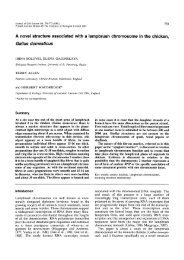European guidelines for youth AIDS peer education - University of ...
European guidelines for youth AIDS peer education - University of ...
European guidelines for youth AIDS peer education - University of ...
- No tags were found...
You also want an ePaper? Increase the reach of your titles
YUMPU automatically turns print PDFs into web optimized ePapers that Google loves.
and-answer sessions, interactive games and role-play. Interaction or discussions between the participantsand an easy-going atmosphere can contribute to learning and the <strong>for</strong>mation <strong>of</strong> new attitudes. Someprojects <strong>of</strong>fer pedagogical sessions as packages that the <strong>peer</strong> educators have learned and amended.The possibility <strong>for</strong> participants to write anonymous questions be<strong>for</strong>e a session is a good method to draw outhonest concerns and allow the <strong>peer</strong> educators to prepare. These can be left in question boxes and discussedby the <strong>peer</strong> educators in front <strong>of</strong> the group.Depending on the age <strong>of</strong> the <strong>peer</strong> educators and the project programme, the presentations can include acombination <strong>of</strong> activities and games which the <strong>peer</strong> educators have been specifically trained to carry out,activities the <strong>peer</strong> educators have developed themselves, and free time <strong>for</strong> questions and discussion.Some projects may <strong>of</strong>fer one or two short sessions to groups and others multi-session programmes. One canexpect little or no long-term behaviour change from one or two short sessions. Depending on disciplineproblems and local laws, an adult may or may not be present in the room. Generally speaking, and assumingorder in the group, <strong>peer</strong> educators have found that the atmosphere is more open and frank if there are noadults present.Outreach approachThe implementation possibilities with this approach vary widely depending on the target group and setting.They can range from lecture and theatre presentations at community <strong>youth</strong> centres to initiating discussionsin cafés, pubs, or on the street. What is most important is that the <strong>peer</strong> educators are identifiable, that thegroup is prepared <strong>for</strong> their arrival and that each is accepted as ‘one <strong>of</strong> us’. This requires publicity andco-ordination with intermediaries during the setting-up phase.Other typical examples are condom distribution, support groups <strong>for</strong> young people with HIV, street theatre,distributing printed in<strong>for</strong>mation, posters, and entertainment events. The objective is usually to raise a targetgroup’s awareness about HIV and risk behaviours, complement other programmes, provide in<strong>for</strong>mationotherwise unavailable due to language or religion, provide in<strong>for</strong>mation adapted to the norms <strong>of</strong>marginalised groups, and encourage safer sex and safe use <strong>of</strong> syringes.Diffusional approachThe diffusional approach relies on spreading in<strong>for</strong>mation and new attitudes or practices through a socialgroup using existing communication networks. This can be verbal, non-verbal or through reports aboutpersonal behaviours and practice. The use <strong>of</strong> natural opinion leaders as credible, trustworthy sources areimportant in the approach. Since there are variations in the values and norms in all target groups varioussubgroups should be included in the project. Once the project is established, popular and ‘owned’ by theyoung people targeted, it might be possible to create opinion leaders out <strong>of</strong> new <strong>peer</strong> educators.The approach relies on the <strong>peer</strong> educators’ live activities and the discussions that result from them in thetarget group. The term ‘live activities’ also includes the in<strong>for</strong>mal and spontaneous face-to-faceconversations between the <strong>peer</strong> educators and the target group members. Generally speaking, teenagersmay infrequently have long serious discussions about HIV, sex and sexual behaviours. The topics may comeupduring short discussions, as joking or as comments. These are not always meaningless exchanges but caninvolve a coded sharing <strong>of</strong> attitudes and beliefs or be used as a means to test new opinions with <strong>peer</strong>s.There is almost an unlimited range <strong>of</strong> activities that can generated through the inspiration and energy <strong>of</strong>the young <strong>peer</strong> educators. Besides in<strong>for</strong>mal discussions, activities could include:• plays and presentations• posters and leaflets• condom distribution• films and videos• live music• festivals• radio and TV programs• articles and newsletters<strong>European</strong> <strong>guidelines</strong> <strong>for</strong> <strong>youth</strong> <strong>AIDS</strong> <strong>peer</strong> <strong>education</strong> 35
















